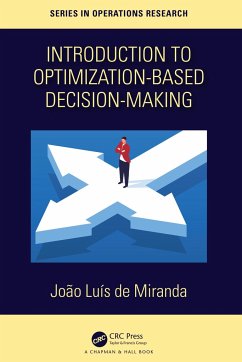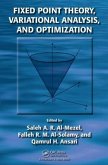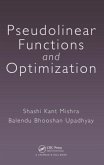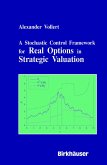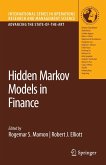Joao Luis De Miranda
Introduction to Optimization-Based Decision-Making
Joao Luis De Miranda
Introduction to Optimization-Based Decision-Making
- Gebundenes Buch
- Merkliste
- Auf die Merkliste
- Bewerten Bewerten
- Teilen
- Produkt teilen
- Produkterinnerung
- Produkterinnerung
This book provides an elementary and self-contained introduction to the basic concepts involved in making decisions in an optimization-based environment. The mathematical level of the text is directed to the post-secondary reader, or university students in the initial years.
Andere Kunden interessierten sich auch für
![Fixed Point Theory, Variational Analysis, and Optimization Fixed Point Theory, Variational Analysis, and Optimization]() Fixed Point Theory, Variational Analysis, and Optimization271,99 €
Fixed Point Theory, Variational Analysis, and Optimization271,99 €![Pseudolinear Functions and Optimization Pseudolinear Functions and Optimization]() Shashi Kant MishraPseudolinear Functions and Optimization239,99 €
Shashi Kant MishraPseudolinear Functions and Optimization239,99 €![Operations Research Operations Research]() Operations Research180,99 €
Operations Research180,99 €![A Stochastic Control Framework for Real Options in Strategic Evaluation A Stochastic Control Framework for Real Options in Strategic Evaluation]() A. VollertA Stochastic Control Framework for Real Options in Strategic Evaluation107,50 €
A. VollertA Stochastic Control Framework for Real Options in Strategic Evaluation107,50 €![Markovian Demand Inventory Models Markovian Demand Inventory Models]() Dirk BeyerMarkovian Demand Inventory Models88,99 €
Dirk BeyerMarkovian Demand Inventory Models88,99 €![Hidden Markov Models in Finance Hidden Markov Models in Finance]() Rogemar S. Mamon / Robert J. ElliottHidden Markov Models in Finance74,99 €
Rogemar S. Mamon / Robert J. ElliottHidden Markov Models in Finance74,99 €![The Price Reporters The Price Reporters]() Owain JohnsonThe Price Reporters206,99 €
Owain JohnsonThe Price Reporters206,99 €-
-
-
This book provides an elementary and self-contained introduction to the basic concepts involved in making decisions in an optimization-based environment. The mathematical level of the text is directed to the post-secondary reader, or university students in the initial years.
Hinweis: Dieser Artikel kann nur an eine deutsche Lieferadresse ausgeliefert werden.
Hinweis: Dieser Artikel kann nur an eine deutsche Lieferadresse ausgeliefert werden.
Produktdetails
- Produktdetails
- Verlag: Taylor & Francis Ltd (Sales)
- Seitenzahl: 241
- Erscheinungstermin: 20. Dezember 2021
- Englisch
- Abmessung: 229mm x 152mm x 16mm
- Gewicht: 526g
- ISBN-13: 9781138712164
- ISBN-10: 1138712167
- Artikelnr.: 62234563
- Herstellerkennzeichnung
- Libri GmbH
- Europaallee 1
- 36244 Bad Hersfeld
- gpsr@libri.de
- Verlag: Taylor & Francis Ltd (Sales)
- Seitenzahl: 241
- Erscheinungstermin: 20. Dezember 2021
- Englisch
- Abmessung: 229mm x 152mm x 16mm
- Gewicht: 526g
- ISBN-13: 9781138712164
- ISBN-10: 1138712167
- Artikelnr.: 62234563
- Herstellerkennzeichnung
- Libri GmbH
- Europaallee 1
- 36244 Bad Hersfeld
- gpsr@libri.de
João Luís de Miranda is Professor at ESTG-Escola Superior de Tecnologia e Gestão (IPPortalegre) and Researcher in Optimization methods and Process Systems Engineering (PSE) at CERENA-Centro de Recursos Naturais e Ambiente (IST/ULisboa). He has been teaching for more than twenty years in the field of Mathematics (e.g., Calculus, Operations Research-OR, Management Science-MS, Numerical Methods, Quantitative Methods, Statistics) and has authored/edited several publications in Optimization, PSE, and Education subjects in Engineering and OR/MS contexts. João Luís de Miranda is addressing the research subjects through international cooperation in multidisciplinary frameworks, and is serving on several boards/committees at national and European level.
1. First Notes on Optimization for Decision Support. 1.1. Introduction.
1.2. First Steps. 1.3. Introducing Proportionality. 1.4. A Non-Proportional
Instance. 1.5. An Enlarged and Non-Proportional Instance. 1.6. Concluding
Remarks. 2. Linear Algebra. 2.1. Introduction. 2.2. Gauss Elimination on
the Linear System. 2.3. Gauss Elimination with the Augmented Matrix. 2.4.
Gauss-Jordan and the Inverse Matrix. 2.5. Cramer's Rule and Determinants.
2.6. Concluding Remarks. 3. Linear Programming Basics. 3.1. Introduction.
3.2. Graphical Approach. 3.3. Algebraic Form. 3.4. Tableau Form. 3.5.
Matrix Form. 3.6. Updating the Inverse Matrix. 3.7. Concluding Remarks. 4.
Duality. 4.1. Introduction. 4.2. Primal-Dual Transformations. 4.3. Dual
Simplex Method. 4.4. Duality Properties. 4.5. Duality and Economic
Interpretation. 4.6. A First Approach to Optimality Analysis. 4.7.
Concluding Remarks. 5. Calculus Optimization. 5.1. Introduction. 5.2.
Constrained Optimization with Lagrange Multipliers. 5.3. Generalization of
the Constrained Optimization Case. 5.4. Lagrange Multipliers for the
Furniture Factory Problem. 5.5. Concluding Remarks. 6. Optimality Analysis.
6.1. Introduction. 6.2. Revising LP Simplex. 6.3. Sensitivity Analysis.
6.4. Parametric Analysis. 6.5. Concluding Remarks. 7. Integer Linear
Programming. 7.1. Introduction. 7.2. Solving Integer Linear Programming
Problems. 7.3. Modeling with Binary Variables. 7.4. Solving Binary Integer
Programming Problems. 7.5. Concluding Remarks. 8. Game Theory. 8.1.
Introduction. 8.2. Constant-Sum Game. 8.3. Zero-Sum Game. 8.4. Mixed
Strategies - LP Approach. 8.5. Dominant Strategies. 8.6. Concluding
Remarks. 9. Decision Making Under Uncertainty. 9.1. Introduction. 9.2.
Multiple Criteria and Decision Maker Values. 9.3. Capacity Expansion for
the Furniture Factory. 9.4. A Comparison Analysis. 9.5. Concluding Remarks.
10. Robust Optimization. 10.1. Introduction. 10.2. Notes on Stochastic
Programming. 10.3. Robustness Promotion on Models and Solutions. 10.4.
Models Generalization onto Robust Optimization. 10.5. Concluding Remarks.
Selected References
1.2. First Steps. 1.3. Introducing Proportionality. 1.4. A Non-Proportional
Instance. 1.5. An Enlarged and Non-Proportional Instance. 1.6. Concluding
Remarks. 2. Linear Algebra. 2.1. Introduction. 2.2. Gauss Elimination on
the Linear System. 2.3. Gauss Elimination with the Augmented Matrix. 2.4.
Gauss-Jordan and the Inverse Matrix. 2.5. Cramer's Rule and Determinants.
2.6. Concluding Remarks. 3. Linear Programming Basics. 3.1. Introduction.
3.2. Graphical Approach. 3.3. Algebraic Form. 3.4. Tableau Form. 3.5.
Matrix Form. 3.6. Updating the Inverse Matrix. 3.7. Concluding Remarks. 4.
Duality. 4.1. Introduction. 4.2. Primal-Dual Transformations. 4.3. Dual
Simplex Method. 4.4. Duality Properties. 4.5. Duality and Economic
Interpretation. 4.6. A First Approach to Optimality Analysis. 4.7.
Concluding Remarks. 5. Calculus Optimization. 5.1. Introduction. 5.2.
Constrained Optimization with Lagrange Multipliers. 5.3. Generalization of
the Constrained Optimization Case. 5.4. Lagrange Multipliers for the
Furniture Factory Problem. 5.5. Concluding Remarks. 6. Optimality Analysis.
6.1. Introduction. 6.2. Revising LP Simplex. 6.3. Sensitivity Analysis.
6.4. Parametric Analysis. 6.5. Concluding Remarks. 7. Integer Linear
Programming. 7.1. Introduction. 7.2. Solving Integer Linear Programming
Problems. 7.3. Modeling with Binary Variables. 7.4. Solving Binary Integer
Programming Problems. 7.5. Concluding Remarks. 8. Game Theory. 8.1.
Introduction. 8.2. Constant-Sum Game. 8.3. Zero-Sum Game. 8.4. Mixed
Strategies - LP Approach. 8.5. Dominant Strategies. 8.6. Concluding
Remarks. 9. Decision Making Under Uncertainty. 9.1. Introduction. 9.2.
Multiple Criteria and Decision Maker Values. 9.3. Capacity Expansion for
the Furniture Factory. 9.4. A Comparison Analysis. 9.5. Concluding Remarks.
10. Robust Optimization. 10.1. Introduction. 10.2. Notes on Stochastic
Programming. 10.3. Robustness Promotion on Models and Solutions. 10.4.
Models Generalization onto Robust Optimization. 10.5. Concluding Remarks.
Selected References
1. First Notes on Optimization for Decision Support. 1.1. Introduction.
1.2. First Steps. 1.3. Introducing Proportionality. 1.4. A Non-Proportional
Instance. 1.5. An Enlarged and Non-Proportional Instance. 1.6. Concluding
Remarks. 2. Linear Algebra. 2.1. Introduction. 2.2. Gauss Elimination on
the Linear System. 2.3. Gauss Elimination with the Augmented Matrix. 2.4.
Gauss-Jordan and the Inverse Matrix. 2.5. Cramer's Rule and Determinants.
2.6. Concluding Remarks. 3. Linear Programming Basics. 3.1. Introduction.
3.2. Graphical Approach. 3.3. Algebraic Form. 3.4. Tableau Form. 3.5.
Matrix Form. 3.6. Updating the Inverse Matrix. 3.7. Concluding Remarks. 4.
Duality. 4.1. Introduction. 4.2. Primal-Dual Transformations. 4.3. Dual
Simplex Method. 4.4. Duality Properties. 4.5. Duality and Economic
Interpretation. 4.6. A First Approach to Optimality Analysis. 4.7.
Concluding Remarks. 5. Calculus Optimization. 5.1. Introduction. 5.2.
Constrained Optimization with Lagrange Multipliers. 5.3. Generalization of
the Constrained Optimization Case. 5.4. Lagrange Multipliers for the
Furniture Factory Problem. 5.5. Concluding Remarks. 6. Optimality Analysis.
6.1. Introduction. 6.2. Revising LP Simplex. 6.3. Sensitivity Analysis.
6.4. Parametric Analysis. 6.5. Concluding Remarks. 7. Integer Linear
Programming. 7.1. Introduction. 7.2. Solving Integer Linear Programming
Problems. 7.3. Modeling with Binary Variables. 7.4. Solving Binary Integer
Programming Problems. 7.5. Concluding Remarks. 8. Game Theory. 8.1.
Introduction. 8.2. Constant-Sum Game. 8.3. Zero-Sum Game. 8.4. Mixed
Strategies - LP Approach. 8.5. Dominant Strategies. 8.6. Concluding
Remarks. 9. Decision Making Under Uncertainty. 9.1. Introduction. 9.2.
Multiple Criteria and Decision Maker Values. 9.3. Capacity Expansion for
the Furniture Factory. 9.4. A Comparison Analysis. 9.5. Concluding Remarks.
10. Robust Optimization. 10.1. Introduction. 10.2. Notes on Stochastic
Programming. 10.3. Robustness Promotion on Models and Solutions. 10.4.
Models Generalization onto Robust Optimization. 10.5. Concluding Remarks.
Selected References
1.2. First Steps. 1.3. Introducing Proportionality. 1.4. A Non-Proportional
Instance. 1.5. An Enlarged and Non-Proportional Instance. 1.6. Concluding
Remarks. 2. Linear Algebra. 2.1. Introduction. 2.2. Gauss Elimination on
the Linear System. 2.3. Gauss Elimination with the Augmented Matrix. 2.4.
Gauss-Jordan and the Inverse Matrix. 2.5. Cramer's Rule and Determinants.
2.6. Concluding Remarks. 3. Linear Programming Basics. 3.1. Introduction.
3.2. Graphical Approach. 3.3. Algebraic Form. 3.4. Tableau Form. 3.5.
Matrix Form. 3.6. Updating the Inverse Matrix. 3.7. Concluding Remarks. 4.
Duality. 4.1. Introduction. 4.2. Primal-Dual Transformations. 4.3. Dual
Simplex Method. 4.4. Duality Properties. 4.5. Duality and Economic
Interpretation. 4.6. A First Approach to Optimality Analysis. 4.7.
Concluding Remarks. 5. Calculus Optimization. 5.1. Introduction. 5.2.
Constrained Optimization with Lagrange Multipliers. 5.3. Generalization of
the Constrained Optimization Case. 5.4. Lagrange Multipliers for the
Furniture Factory Problem. 5.5. Concluding Remarks. 6. Optimality Analysis.
6.1. Introduction. 6.2. Revising LP Simplex. 6.3. Sensitivity Analysis.
6.4. Parametric Analysis. 6.5. Concluding Remarks. 7. Integer Linear
Programming. 7.1. Introduction. 7.2. Solving Integer Linear Programming
Problems. 7.3. Modeling with Binary Variables. 7.4. Solving Binary Integer
Programming Problems. 7.5. Concluding Remarks. 8. Game Theory. 8.1.
Introduction. 8.2. Constant-Sum Game. 8.3. Zero-Sum Game. 8.4. Mixed
Strategies - LP Approach. 8.5. Dominant Strategies. 8.6. Concluding
Remarks. 9. Decision Making Under Uncertainty. 9.1. Introduction. 9.2.
Multiple Criteria and Decision Maker Values. 9.3. Capacity Expansion for
the Furniture Factory. 9.4. A Comparison Analysis. 9.5. Concluding Remarks.
10. Robust Optimization. 10.1. Introduction. 10.2. Notes on Stochastic
Programming. 10.3. Robustness Promotion on Models and Solutions. 10.4.
Models Generalization onto Robust Optimization. 10.5. Concluding Remarks.
Selected References

